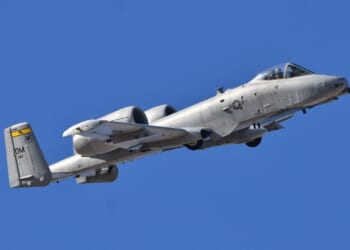Boeing must build an aircraft that achieves breakthroughs in aerodynamics, propulsion, AI, data fusion, and human-machine teaming—no small task for the beleaguered aerospace firm.
Air Force Chief of Staff Gen. David Allvin recently confirmed that the F-47 fighter, previously known as the Next Generation Air Dominance (NGAD), had entered production at Boeing’s St. Louis facility, with its prototype’s first flight expected to take place in 2028. The milestone comes only six months after Boeing was awarded the NGAD contract over rival Lockheed Martin, a coup for the beleaguered Seattle-based aerospace manufacturer.
“In the few short months since we made the [F-47] announcement, they are already beginning to manufacture the first article,” Allvin said during his keynote address at the Air & Space Forces Association Air, Space & Cyber Conference. “We’re ready to go fast. We have to go fast.”
But can Boeing—which has become tainted in recent years with a string of high-profile delays, production failures, and aerial catastrophes—actually make this timeline?
Boeing’s Turbulent Path to the F-47 Contract
Boeing has been through a difficult stretch. The recent 737 MAX crisis was fully of Boeing’s own making. After two 737 MAX airliners crashed, killing a combined 346 people, Boeing initially tried to shift the blame to foreign pilots. A subsequent investigation showed that the planes’ error-prone MCAS system was at fault, leading to a global backlash against Boeing and the grounding of its 737 MAX fleet.
Boeing’s persistent quality control issues have hampered other projects, including the 787 Dreamliner, 777X, KC-46 tanker, and T-7A Red Hawk. Much to the ire of President Donald Trump, Boeing has been unable to complete the two replacement aircraft for Air Force One on time, leading the president to solicit a donated aircraft from the Qatari royal family instead. In the most notorious incident of the past year, technical problems with Boeing’s Starliner capsule left NASA astronauts stranded at the International Space Station for months—before private space firm SpaceX came to the rescue.
Nevertheless, Boeing secured the NGAD contract in March, suggesting the aerospace giant was rebounding. During his keynote, Allvin took the time to laud Boeing’s workers, showing a video of Boeing employees at the company’s fighter production facility cheering loudly the morning that Trump announced Boeing would win the NGAD contract.
“Those aren’t people who just show up to work,” Allvin said. “Those are people who are committed to do something great for the nation. And there are Americans on shop floors all across the country, in the labs, out on the flightiness doing the tests. They want to put together the dominance for the future.”
Building the First Sixth-Gen Fighter Will Be a Herculean Task
Building the F-47 will be no simple task. The jet will be the world’s first operational sixth-generation fighter—and the centerpiece of a family of next-gen systems, featuring stealth, speeds exceeding Mach 2 (1,522 miles per hour at ground level), a combat radius exceeding 1,000 nautical miles, and integration with “Collaborative Combat Aircraft” autonomous drone wingmen.
In short, to pull off the finished product, Boeing must build an aircraft that achieves breakthroughs in aerodynamics, propulsion, AI, data fusion, and human-machine teaming. Not all of those breakthroughs will fall to Boeing singularly; all modern fighter aircraft have systems that are subcontracted out to other major firms. But the bulk of the task is in Boeing’s hands—a company that has, in recent years, repeatedly failed to deliver on far simpler programs.
For generations, Boeing was renowned as an engineering-led company, in which business and financial decisions came secondary to making great aircraft. The company’s recent failures have been attributed in large part to a shift away from an engineering-first ethos towards a more corporate priority set, which prioritized cutting costs and raising shareholder value. In effect, the MBAs took charge from the engineers—to disastrous results.
Hopefully, a reversion of sorts has occurred in the years since the MCAS software forced two Boeing jets into an unrecoverable nose dive. The F-47 will be the most advanced fighter platform ever built, a replacement to the Lockheed Martin F-22 Raptor, meant to ensure continued aerial dominance for the foreseeable future. The stakes are high. The margins are slim. And for Boeing, in the years to come, nothing short of perfect will be acceptable.
About the Author: Harrison Kass
Harrison Kass is a senior defense and national security writer at The National Interest. Kass is an attorney and former political candidate who joined the US Air Force as a pilot trainee before being medically discharged. He focuses on military strategy, aerospace, and global security affairs. He holds a JD from the University of Oregon and a master’s in Global Journalism and International Relations from NYU.
Image: Wikimedia Commons.















